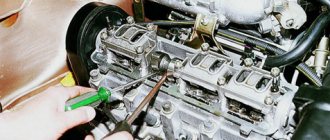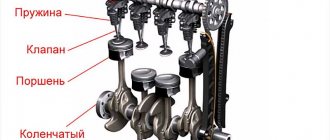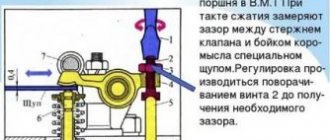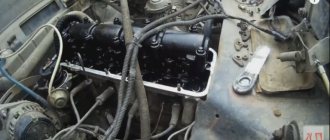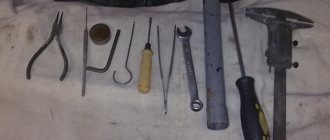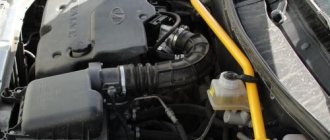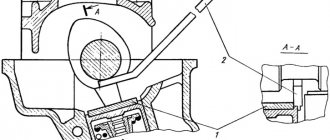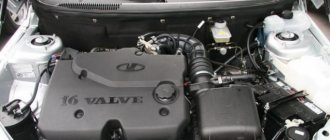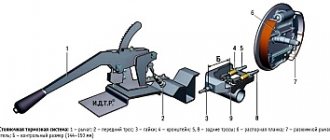Adjustment of valve clearances is required to maintain optimal thermal clearances between timing elements. When heated, the metal expands and the gaps between engine parts decrease. All engine clearances are calculated in this way. What is their optimal value. It is installed when the engine reaches a temperature of 80 to 120 degrees. That is, at these temperatures the engine operates optimally.
Can be operated at maximum power. For this reason, a warm-up procedure for a cold engine is necessary. First of all, in order to establish optimal clearances between engine parts. that is, we install thermal gaps. which are designed for thermal expansion of engine parts. So that when heated they become as small as possible. But they excluded the possibility of their complete absence. Valve clearances should be as small as possible. To ensure the opening and closing of valves. No delay to bridge the gap.
What you need to know in order to correctly measure the gap
Adjustment of the valve mechanism is carried out only after setting the cylinder pistons to the TDC position, with both valves (intake and exhaust) closed. In this case, the rocker arms can move freely. To adjust, you need to use a wrench to loosen the lock nut of the adjusting screw, which is tightened after completing the adjustment procedure. You should be extremely careful here, since as a result of improper tightening, the gap size may change up or down
Therefore, it is very important to tighten the locknut correctly and then recheck the gap. Therefore, all cylinders must be checked
Rotate the crankshaft exclusively clockwise; for greater accuracy of its installation, be sure to use a special key or crank handle.
https://youtube.com/watch?v=vbmJ-CYox2A
How to ensure the required clearance
The required clearance can only be obtained through properly carried out adjustment work. When carrying out this process, the main gas distribution mechanism is adjusted, especially the gap located between the camshaft cams and the valve lever.
There are special instructions on how to make the adjustment. It is not enough to ensure that the valves are pressed more tightly, since as the temperature rises, all parts become larger in size. Such an expansion automatically leads to various negative consequences.
The intake and exhaust valves should close the seat tightly, but with a small gap. It is necessary to ensure that the valve stem does not rest rigidly on the top of the device.
In the process of self-regulating gaps, you need to strive for strictly established values. They should not be more than 0.15 mm. The maximum permissible error level is 0.05 mm. These parameters should be checked only with a cold engine.
By ensuring the correct clearances during the adjustment process, the driver will receive stable engine operation, significant fuel savings, and increased service life.
Instructions
Before starting work, allow the engine to cool completely. Check the timing marks and chain tension - correct if they do not meet the standards. The instructions will describe the method of adjustment using a micrometer.
Carburetor pan VAZ 2106
Adjustment using the old-fashioned method (with a feeler gauge) is performed in the same sequence, with the exception of the point about measuring gaps.
- Remove the carburetor pan and remove the hose from it.
- Disconnect the accelerator pedal drive.
- Remove the valve cover of the Six power unit.
- Remove the ignition distributor cover.
- Turn the engine by the flywheel. Turning is done with a special key. Removing the spark plugs will make the turning procedure easier. As a result of turning the power unit, the marks on the camshaft sprocket should align with the mark on the bearing housing. For complete reliability, you can check the coincidence of the marks on the crankshaft pulley and the engine.
- Mark the marks on the camshaft sprocket with a marker. Marks are applied on top of the factory ones every 90 degrees.
- Screw the rack onto the camshaft bed mounting. It must be securely fixed.
- Place the indicator on the rack.
- Place the indicator on the edge of the adjustable valve cam.
- Engage the cam using the special grip and pull up. There should be a change in indicators by 52 divisions.
- If there is a deviation in the indicator, the gap needs to be adjusted. Using a size 17 wrench, you need to unscrew the lock nut 1-2 turns and use a size 13 wrench to adjust the gap. After this, carry out another check of the adjustment with a micrometer. If everything is correct, tighten the locknut. After this, you need to re-check the gap - the gap may have decreased after tightening the locknut. When adjusting the gap, you need to leave a margin.
All engine valves are adjusted in this way. To get to the valves you need to crank the engine. There is a clear procedure for adjusting the valves. It is indicated in the adjustment table.
Gap table for correct engine valve adjustment.
At the end of the procedure, it is advisable to crank the engine and check the clearances again. The structure is assembled in the reverse order. Be sure to replace the disposable valve cover gasket.
https://youtube.com/watch?v=yxh1d_RaOwQ
We repair a VAZ 2106 car ourselves:
- Adjusting the ignition of a VAZ 2106 on your own
- Tuning VAZ 2106 on your own
- Do-it-yourself VAZ 2106 starter repair
How to adjust valve clearances on foreign cars
First of all, using the repair and maintenance instructions for your car, we determine the engine type. The fact is that some foreign cars can have up to ten types of engines on one car model. The tool required for adjusting and installing timing marks is also indicated there. However, in most cases a set of wrenches and feeler gauges is sufficient. Let's look at the features of adjusting clearances on a Mitsubishu ASX 1.6 with a gasoline and diesel engine.
Gas engine
This is what a Mitsubishu ASX 1.6 engine with a gasoline engine looks like.
To do this, follow these steps:
- Remove the plastic engine casing (held on by rubber latches).
- We remove the ignition coils and valve cover.
- We set both camshafts according to the marks (the nominal clearances of the intake and exhaust valves are also indicated here). We set the marks of the engine camshaft
- Using feeler gauges, we measure the gaps “Second and fourth cylinder - intake valves”, “First and third cylinder - exhaust valves”. We record the measurement results.
- Rotate the crankshaft 360 degrees. Then we align the marks on the camshafts and measure the clearances of other valves. We check the size of the engine valve clearances
- We remove both camshafts, take out the adjusting cups and use the given formula to calculate the size of the new cups. We adjust the valve clearances
- We install new cups and install the camshafts in the cylinder head.
- Apply sealant to the indicated places and tighten the valve cover. Apply sealant and tighten the engine valve cover
Adjusting engine valves.
Adjustment of valve clearances in all internal combustion engines follows the same principle. Independent of. design features of the timing system. Four-stroke engines, both gasoline and diesel, have the same general design. Knowing the general principle, you can adjust the valves on any car engine.
What you need to know when adjusting valve clearances.
The order of operation of the cylinders of a 4-cylinder engine.
If one cylinder fires. after him the next one starts working. Which one. depends on the engine design. If the engine has in-line cylinders. The crankshaft has this structure
The first cylinder fired, the next one will be either 2 or 3
For 2 there will be 4, for 3 - either 4 or 3
Therefore, the order of operation of the cylinders of a 4-cylinder in-line engine will be as follows
1-2-4-3
Or like this
1-3-4-2
Other engine designs have a different cylinder firing order. It is important to know the firing order of the cylinders for each engine. To regulate the valves of the exact cylinder that is at TDC at the moment of compression.
If we have a working order of 1-3-4-2, this means that first we adjust the first cylinder then 3 then 4 then 2
Preparatory work
Before starting the adjustment, you should perform the following operations:
- remove the air filter housing from the carburetor;
- remove the pipes and wires that prevent the dismantling of the timing cover;
- unscrew the nuts securing the timing cover;
- remove the timing cover.
Tip: for convenience, it is worth removing the distributor cover, this will make access to the valve mechanism easier. You also need to unscrew the spark plugs - without them there is no compression in the cylinders and it is much easier to turn the crankshaft.
When access to the valves is ensured, you can begin adjusting the thermal clearances. It should be remembered that the gap value of 0.15 mm was set by the designers for a cold engine. Therefore, before carrying out work, you must wait until the engine has cooled down. In addition, working on a hot engine can cause burns.
Adjusting the valves on a VAZ 2107 carburetor and on an injection model is absolutely no different. The only exceptions are engines on which hydraulic clearance compensators are installed. In this case, no adjustment is required.
Specifics of the work
There are drivers and car owners who want to do all the repair work or replacement of consumables with their own hands. This is very important for owners of Russian cars, especially carburetor classics, including the VAZ 2106, and this is very good. There are some jobs, including adjusting valves, for which knowledge in the sequence of work and experience will not be sufficient; you also need a presentiment, which is not always hostile, but is often achieved with experience, by making mistakes.
That is why, if for the first time you decide to independently adjust the valves on a VAZ 2106 carburetor, then it is important to invite a person who has already performed this type of work more than once, but at least more than 5 times, it is important that the make of the car is the same. Be sure to look and check the tension of the timing belt before starting work. A vehicle's timing belt (timing belt) is needed to transmit rotation from the engine crankshaft to the camshaft.
It is very important that the engine is cooled, but not too cool, the engine temperature should be about 30-40 degrees, this is the best temperature. If you have driven a car and want to start working on adjusting valves or other parts, you must let the engine cool down; this will take about 6 hours. To speed up the cooling process, you can remove the valve covers and other parts; this will help the engine cool down twice as fast, in about 3 hours. According to the law of physics, this will increase natural heat transfer processes. But it’s better not to rush anywhere, but to carry out the adjustment the next day. Be sure to buy a valve cover gasket in advance so as not to have to run around for it later, since when making adjustments, it almost always needs to be changed.
Purpose of valves in an engine
During operation, the engine consumes air and fuel and emits exhaust gases. The valves allow air-fuel mixture to enter the cylinder (through the intake valve) and exhaust gases to be removed (through the exhaust valve). The alternation of intake and exhaust cycles is called the engine duty cycle. It consists of four measures.
- Inlet. Inlet valve is open. The piston moves downwards and, due to the vacuum created in the cylinder, carries with it the air-fuel mixture, which enters through the open intake valve.
- Compression. Both valves are closed. The piston moves upward (toward the spark plug) and compresses the air-fuel mixture.
- Working progress. Both valves are closed. The spark plug produces a spark that ignites the air-fuel mixture. During combustion of the air-fuel mixture, a lot of gas is formed, which pushes the piston down.
- Release. The exhaust valve is open. The piston moves up and pushes exhaust gases out of the cylinder through the open exhaust valve. The engine operating cycle consists of four strokes, during which the working mixture enters, is compressed and burns, then the exhaust gases are removed
The meaning of valve adjustment
The opening of the valve is controlled by the camshaft cam. When the engine is running, the valve heats up and elongates, which can cause it to not close completely. To compensate for this elongation, there is a gap between the valve and the camshaft cam. The point of adjusting the valves is to set the required value of this gap.
Signs of improper valve adjustment
Signs of improperly adjusted valves include:
- Extraneous metallic knocking noise from under the valve cover.
- Reduced engine power.
- The smell of pure gasoline in the exhaust gases.
Adjusting the valves on VAZ 2107 cars is mandatory after repairing the gas distribution mechanism, as well as after a mileage of 10–15 thousand kilometers.
Adjustment features for an injection engine
The VAZ-2109 valve adjustment described above (carburetor) is also suitable for an injection engine. The only difference lies in the preparatory process. When preparing for work, several other actions are required, namely:
- remove the throttle cable;
- remove the breather hose.
Now you know how to correctly adjust the VAZ-2109 valves. An injector or carburetor powers the engine - this does not play a significant role, because the design of the engine itself remains the same.
The procedure for measuring the gap and adjusting it is very simple and requires the owner to perform it in the correct order. The entire procedure can take no more than 30 minutes.
We hope that with the help of this article you will be able to complete the adjustment yourself, and the savings will be a worthy bonus for your efforts.
When to adjust valves
If your engine does not have devices to maintain the required clearance automatically, then you need to be prepared for the fact that every 30-35 thousand km. the indicated gaps must be checked.
Let us add that many car enthusiasts, especially owners of domestic VAZ models, determine the need for adjustment based on the appearance of noise during operation of the valve mechanism.
On foreign-made cars, the need to adjust the valves may arise after 60-80 or even 100 thousand km. mileage, since the engines have a longer service life and the set gaps on such internal combustion engines remain more stable.
Wear problems
The displacement of valves from their seats entails several negative factors:
- Increased fuel consumption due to unstable operation and interaction of pistons and valves. In the process of shifting the location of the valve, it does not perform its function so accurately; the overall efficiency decreases, causing mechanical losses in operation, which in turn leads to an increase in the car’s fuel appetite;
- Increased natural wear of engine parts. Parts made of steel are subject to constant impact and wear out over time. However, wear processes can be stimulated by inaccuracy in the placement of parts, and valves serve as a striking example. As the required clearances increase, wear increases and, accordingly, the overall engine life is reduced.
Therefore, engine valves require periodic adjustment in order to maintain the wear resistance of the entire vehicle system. In modern engines equipped with hydraulic compensators, the valve adjustment procedure is not required; the 402 engine does not belong to this series and requires periodic adjustment.
On video how to adjust valves on a 402 engine:
Manual adjustment of internal combustion engine valves
In the process, special adjustment screws of the rocker arms are adjusted. On some vehicle models, adjustment can be made using the head of a special adjusting bolt. You must use a specific key
It is very important to do everything correctly. Let's look at the setup process using the VAZ 2107 as an example.
Before making adjustments, it is necessary to remove the spark plugs from the cylinders (this requires a special key), then remove the air filter, cylinder head cover and timing belt protection (the number of elements whose removal is required depends on the specific car model). The entire gas distribution mechanism opens before us. In order to perform valve adjustment as efficiently as possible, it is necessary to evaluate the tension of the timing chain. If it is loose, the chain should be tightened.
The procedure begins by setting the first engine piston to the initial compression stroke position (TDC). To do this, you need to find a long mark on its body and a mark on the crankshaft pulley, and combine them (the mark on the timing gear should coincide with the mark on the timing case). To adjust, you will need a set of feeler gauges and wrenches “13” and “17”. Directly, the process itself:
- In the installed position of the power unit, the thermal clearances of valves 6 and 8 are adjusted.
- We check the gap using a feeler gauge, which we place between the valve rocker and the cam. Ideally, it should enter with little effort, in which case the valve does not need adjustment. If the probe slips or does not enter, the valve needs adjustment.
- Take the key set to “17” and loosen the locknut.
- Using the key set to “13” we adjust the valve mechanism.
- As soon as the gap is adjusted, it is necessary, using a wrench set to “13”, to hold the bolt for adjustment, and with a wrench set to “17”, tighten the lock nut.
- After tightening the locknut, check the gap with a feeler gauge and adjust it if necessary.
- After the second valve is adjusted, it is necessary to turn the crankshaft clockwise 180. With this position, the clearances on valves 4 and 7 are adjusted.
- The next time you turn the crankshaft 360 from the starting position, valves 1 and 3 are adjusted, and when you turn 570, valves 2 and 5 are adjusted.
- All work is carried out by analogy with the adjustment of 6 and 8 valves.
Starting the power unit after the procedure will provide an opportunity to evaluate how correctly it was carried out. In this case, the quality of valve adjustment must be assessed under different engine operating modes.
Gap measurement
Determining and checking which valve clearances are present should be carried out exclusively on a cold engine.
To carry out this operation, you will need to prepare a dipstick and other additional tools, the choice of which depends on the category of the valve pusher. This can be a spanner or open-end wrench, a hammer, a micrometer or a puller. The processes involved in measuring gaps are carried out in different ways.
To measure the thermal clearance on a pushrod with a special screw adjustment, the crankshaft must be rotated so that its cam is directed in the opposite direction from the pushrod. Next, you need to lightly hit the pusher with a hammer and swing it slightly to the sides with your hands. Using a feeler gauge, the gap between the valve and the pusher is measured, and then checked with the value specified in the car’s operating instructions.
To measure the thermal gap on a motor with shim adjustment, the crankshaft must be rotated so that the cam of the selected valve points upward. Using a probe, measurements are taken and also compared with the indicators in the car’s instructions.
If, as a result of the measurements taken, it becomes clear that the indicators are deviated from the norm, adjustment will be required.
Why are valves needed?
The task of the gas distribution mechanism is to “drive” as much of the fuel mixture as possible into the combustion chamber and remove exhaust gases from it into the exhaust system as efficiently as possible. It is this task that is performed by the valves that ensure engine operation on the intake and exhaust strokes.
There are two types of valves installed in the cylinder head:
- inlet Responsible for getting the gas-air mixture into the cylinders;
- exhaust outlets responsible for the timely removal of fuel combustion products.
Each engine cylinder is equipped with a valve mechanism, and, depending on the configuration used, their number ranges from 2 to 5.
- The two-valve system is used on older type engines and consists of 1 intake and 1 exhaust valve.
- The four-valve system is the most popular, and almost all modern engines are equipped with it. In it, the valves work in pairs.
- The five-valve system is found on certain Audi engine models, and is not popular. The reason for this lies in the high complexity of the gas distribution mechanism and the virtual absence of advantages over a standard four-valve engine.
Interaction of gas distribution mechanism parts
The camshaft, rotating, presses the cams onto the adjusting washers, which are located in the pushers mounted on the ends of the valve stem. Thereby pushing the parts whose caps are located in the valve seats. The seats and caps are very precisely ground to each other, this is done so that at the moment when the cap of the part is completely seated, a hermetically sealed connection is formed into the saddle. The channel is completely blocked.
This is why the engine runs stably and produces the required power, saving fuel. As the engine operates, the working surface of the cams wears out, they lose their dimensions, and the gaps increase.
Because of this, the caps do not fully adhere to their saddles, as a result of which the tightness of the saddle-cap connection is lost. In order to restore this tightness, adjustment of the VAZ valve clearances is required. For this purpose, adjusting washers are used. These washers themselves are round in shape and the circumference diameter is the same as that of the pusher (pos. A in the figure above). The photo below shows some examples of these round washers:
Here are eight washers of different thicknesses. The thickness is written on the washer itself in millimeters. Valve clearances are adjusted by selecting washers of the required thickness. Sometimes you have to change these washers several times, each time inserting a washer of a different thickness, until the valve clearance reaches the desired size.
They are usually sold in sets starting from a thickness of 3mm, the next size is 3.05mm. And so on every 0.05mm, up to a size of 5mm.
Adjustment features and dimensions
The main condition in this matter is that the engine must be cold. Those. its temperature should be no more than 20 degrees Celsius.
We will carry out further actions by looking at the figure below. For ease of operation, it is better to unscrew the spark plugs! This will make it easier to operate all the mechanisms and shafts involved in this process, since there will be no compression. Turn the crankshaft so that the mark on the camshaft pulley coincides with the mark on the rear cover of the gear shaft (tendril).
We must immediately examine the remaining marks in the crankshaft area. They should be located exactly as shown in the figure. This means that the piston of the first cylinder is in the TDC position. Next, you need to turn the crankshaft by about forty to fifty degrees, this is necessary so that the camshaft cams turn from the pushers.
Using feeler gauges, you need to measure the gaps of the 1st, 2nd, 3rd and 5th valves. The gaps on the 2nd and 3rd valves should be (0.2+-0.05mm.). On the 1st and 5th valves the gap should be (0.35+-0.05mm). If some gaps do not correspond to the standard, then they are brought to the required dimensions by replacing the adjusting washers, selecting them until the goal is achieved.
After this, you need to rotate the crankshaft 360 degrees, i.e. one full turn and check the clearances on the 4th, 6th, 7th and 8th valves. On the 4th and 8th cylinders the gap should be (0.35+-0.05mm). On the 6th and 7th cylinders, the clearance should be (0.2+-0.05mm). Well, accordingly, if there are incorrect gaps, we correct them in the same way as the first time.
